How Plumbing is Like Writing
Deborah Ann Lucas
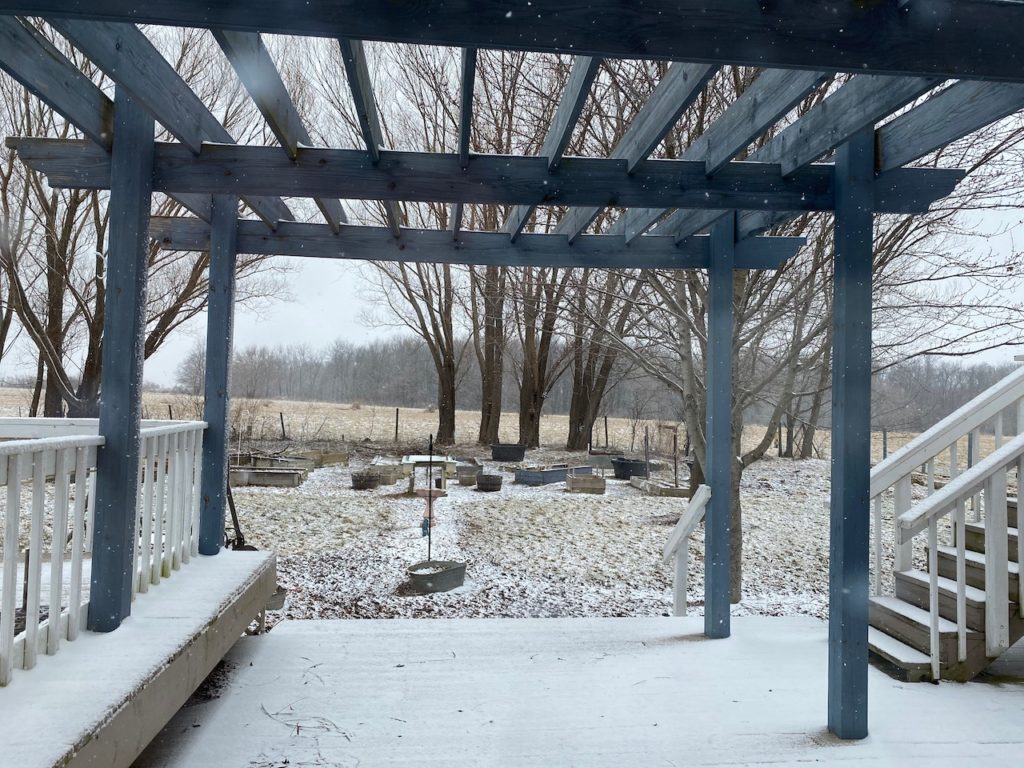
Plumbing and Writing in Crazy Times
Three weeks ago, just as all this Covid-19 craziness began to complicate everyone’s daily life, my husband Greg decided to tackle a do-it-yourself project which required cutting off our water supply. It was a snowy day, good for inside projects, but I had my misgivings on doing a DIY plumbing project. We’d done plumbing for this house before but not for over a decade. Like with most of our other home projects, we encountered problems, then learn from the experience. My familiar fear of a potential nightmare created an opportunity for me to practice kindness, patience, and problem-solving. So, here’s how plumbing is like writing.
Building On Good Bones
We bought this house 25 years ago in a half-finished, poorly-renovated condition. Why? Because it gave us a place to land with our three dogs, three cats, and five horses during a difficult time in our lives. We faced an overwhelming number of repairs and chose to accept the challenge because we saw the farm’s good bones on which to build a new life. This neglected farmhouse on six (now twenty) acres had potential. It just needed a lot of tender loving care to become the home of our dreams. And so, we’ve worked year after year, project after project, solving one problem after another. Even now, some of those original problems are still waiting to be resolved—like the water system.
The same is true for my writing as I work to build a good story on memories of a dilapidated past with good bones.
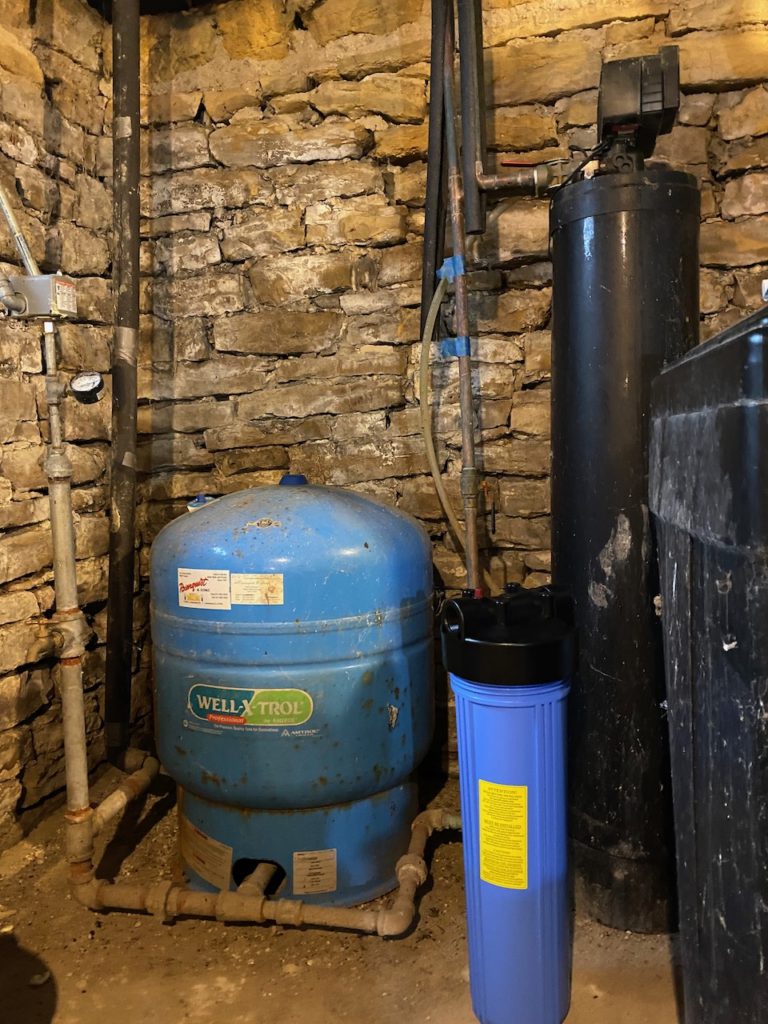
The Problem
When we first moved in, the house’s existing well reached less than 30 feet down to the shallowest aquifer. Because of surface runoff contamination, a chlorinating system had been installed in the dirt-floored basement, making the well water barely safe for drinking. As a stop gap measure, we added an RO drinking water filtration system. A few years later (as soon as we could), we hired a third-generation well-digger to drill an over 300-foot-deep well which he lined with two layers of pipe to protect it from surface water contamination (he had to go that deep to get enough water flow). The new pressure tank pumped uncontaminated, delicious and plentiful water into the house.
However, we continued to experience an intermittent low water flow, especially on the second floor. We started finding tiny grains of sand clogging all the faucet screens. Even with regular cleanings, we suffered with restricted water flow. We couldn’t keep the screens clean long enough for a hot shower. Our on-demand water heater that replaced our tank heater to save energy shut off when the flow became too low, usually about half way through my shower. To assure hot water for my entire shower, I ran the hot water in the sink while taking a shower, letting water and the energy to heat it go down the drain. Shorter, less frequent showers became the norm and, for years, we’d been unable to discover an affordable solution.
The Writing Connection
Quality and flow (pacing) are also issues I’ve been addressing in my writing. Through editing, I’m learning to clean up the repetitive, excess, and poorly chosen (contaminated) vocabulary. My pacing gets clogged up with unnecessary diversions into subplots, overly long backstory, and excessive description (grains of sand). To fix it, I need better filtering. I struggle deciding when to tackle the problem. Too soon in the writing process and I get in the way of getting the inner journey and subsequent plot down on the page. If I wait too long, I create stress about letting go of my darlings and meeting deadlines. Get the timing wrong and a problem can become a disaster. It’s the same with plumbing repairs.
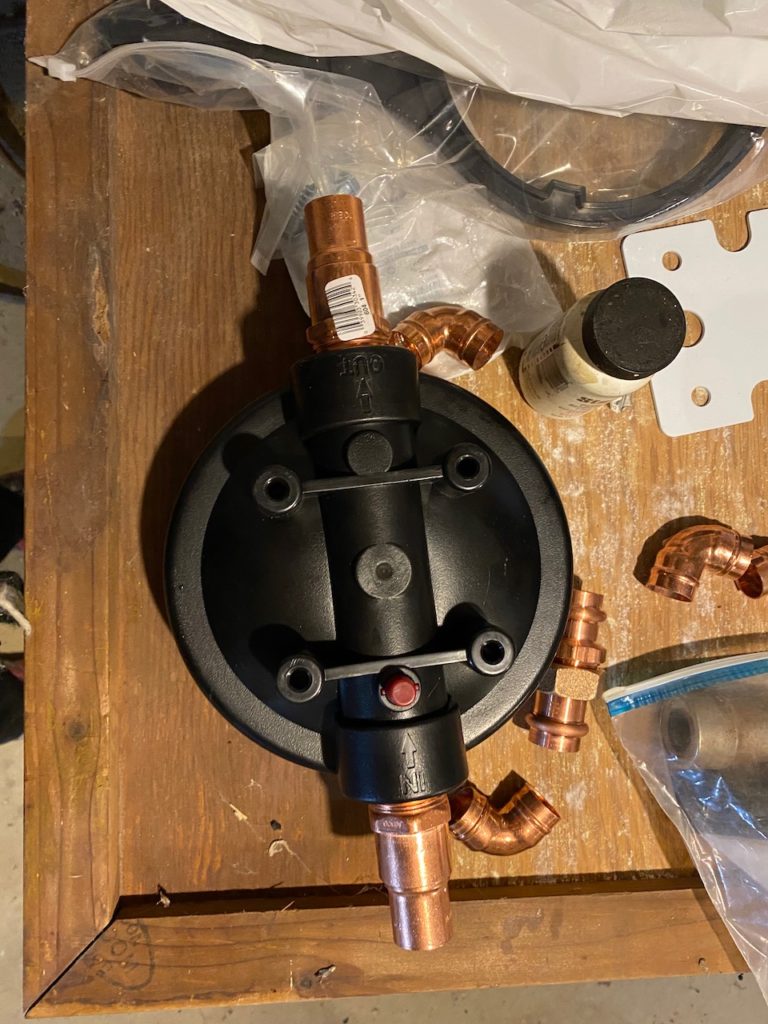
A New Problem
Despite my worries of finishing the filter project successfully (without leaks), Greg seemed confident and adamant about doing it that weekend. I questioned him about the process, reviewed his research and surmised what might go wrong, but he persisted. I followed him into the basement (now with a concrete floor) to see his plan for installing the new water/sand filter. He pointed to where it would fit into our existing plumbing.My mouth dropped open The new problem: the limestone foundation wall behind where he wanted to install the filter had gaping holes between the stones. It needed tuck-pointing with mortar, but once he added the copper pipes to reroute the water through the filter, it would be inaccessible.
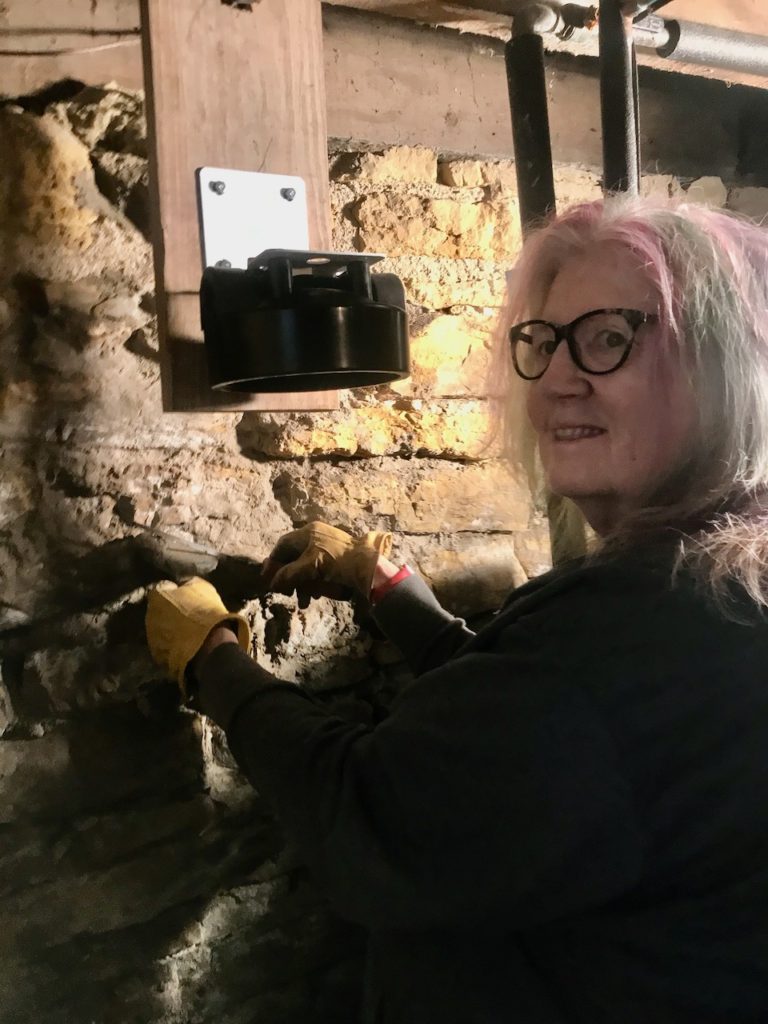
An Old Foundation
Our 19th century basement walls were constructed of irregular chunks of field limestone. The existing house is not as old. We figured out the original house burned down, and the owners built a new house in its place sometime before 1920. Since then, foundation walls have deteriorated from rain that flowed off the two-story roof and seeped between the stones, loosening and, in some spots, totally removing the old mortar. I’d repaired much of it over the years, a section at a time, but between other projects and my physical limitations (two replaced shoulder joints and arthritic hands), I’ve never finished it.
So, as Greg worked on gathering tools and laying out parts, I began tuck-pointing the area behind where the filter would be installed. All day Saturday then again on Sunday morning, I mixed mortar into a small bucket, getting all the powder wet but not watery then stuffed it in between stones with a narrow flat tool specially designed for tuck-pointing. I took short breaks between batches to rest my arthritic hands and knees. It’s detailed work that takes time and patience. The more I pondered cutting the waterline, the more worried I became. What if, when we cut into the copper pipes, we ran into a problem—like a leak—and didn’t have time to fix it before Greg returned to work the next morning?
I was also aware of how another house project was impinging on my writing time but reminded myself that if I didn’t have this house, this land, this place as my nature retreat, I may never have been able to write a single word. Every day, it soothes my anxiety and quells my fears when I look out the window, even more so when I walk in the garden or the woods.
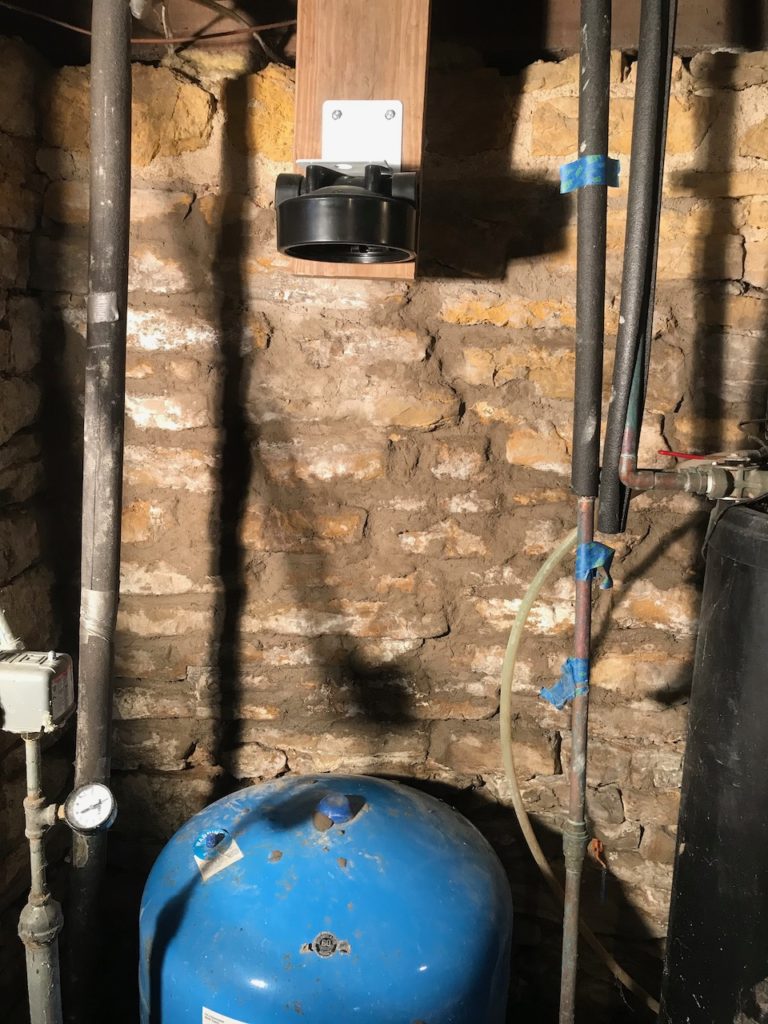
No Water
We live on a hill in the middle of corn fields. When a storm knocks a limb onto a power line, we are left without power. Our generator isn’t big enough to run the well nor the heating system.
We’ve managed pretty well for a night. But for a week? Imagine buying and carrying enough water to refill two 150-gallon tanks for the horses. Nearly impossible.
And so, before starting the water project on Saturday, we filled the horses’ tanks. We could get by for a week. The dozen gallons of water we keep stored in the basement would be enough for Killian our GSD, our two indoor cats, and us to drink with enough left over to make coffee and wash hands, but not enough for cooking, bathing, and flushing toilets. It’s like camping out inside.
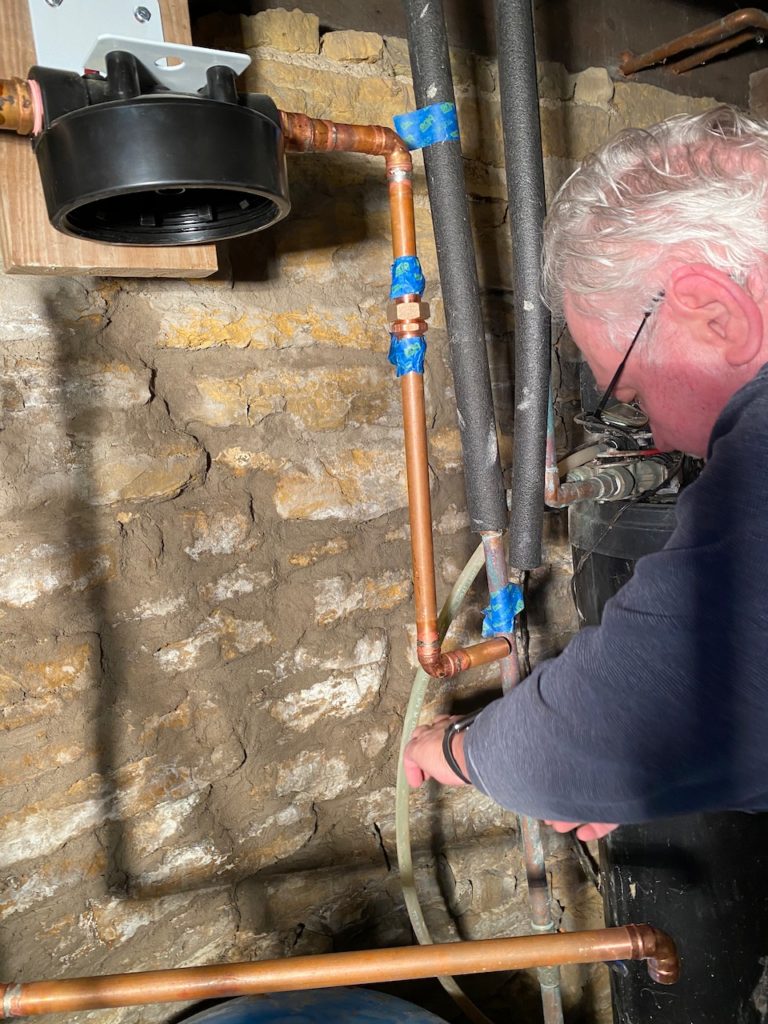
Worst Fears Realized
On Sunday afternoon, despite my fears, we cut into the existing copper pipe. Greg took extra care to thoroughly sweat (as in soldering) each joint and elbow that we added so it wouldn’t leak.
With that done, he twisted the filter into place. It fit together perfectly. So far so good. For the next step, I held my breath. Greg turned on the valves to let the water flow. He signaled to me to flip the breaker to power up the pump.
Water squirted out from several junctions of pipe and from the top of the filter. Greg held up his hand, telling me to wait before freaking out. The instructions for the filter and compression settings said it might need a minute to get the pressure up enough so that everything could seal. At least the copper joints we’d sweat weren’t leaking. I took a breath, then another. The leak didn’t slow.
Greg said a few choice cuss words as we shut off the power to the pump and closed the water valves.
Writing Rejections
This moment reminded me of how I felt getting rejection after rejection from agents. After I’d edited the manuscript multiple times, working with book coaches and beta readers, I thought they would have fallen in love with my story of horses helping to heal a lost girl (fiction taken from my own life). But the rejections kept coming.
Sure, I was frustrated, but did I throw up my hands and give up on my writing? I might have wanted to, but no way! After getting reassurance from coaches and writer friends, I repeated to myself I wasn’t alone in feeling like a total failure, took some time to analyze the problem, recruited more help and encouragement, then went back to work. Nothing else made sense. I wasn’t about to throw out all those years of work. Although I could have made the process more painful with well-practiced self-flagellation. Or I could accept the problem and kick into high gear to find a solution.
I chose the latter—for my writing and for the plumbing.
Kindness and Patience
As Greg and I mopped up the water from the basement floor, I bit my tongue (figuratively). Saying “I told you so” wouldn’t help either of us feel better nor would it get the problem solved. Instead, I reassured Greg that we’d figure it out, just like we had on so many other DIY projects over the years.
I took photos of what we had done so far then followed Greg upstairs to search Google and YouTube for some hint as to what went wrong. Then I suggested Nicholson’s. It’s the best hardware store in Rockford. Maybe they could see something we couldn’t and explain how to fix it.
Of course, by now it was Sunday evening and the hardware store was closed. Greg was the one who needed to hear their advice (better than me trying to relay it) but had to work in the morning. So, he sent off a quick email to his boss, explaining that he needed to take an unplanned vacation day. (Reminder: this was still before social distancing was enacted.)
We fed the cats and Killian, filled their water bowl from our stash of glass jugs, and microwaved some frozen dinners for us. After leaving our dirty dishes on the counter, we returned to our research, thankful we still had power. We didn’t yet know the full extent the pandemic—how it would impact our lives and heighten our stress levels. If we had, we might never have risked starting the project in the first place. But I was wasting energy thinking of what might have been. I needed to focus on a solution, one within my grasp.
The Solution
Greg’s research gave him an inkling of what went wrong. When he’d designed the new plumbing, he included two compression fittings (joints not needing sweating) so that later we could easily remove the filter if needed. The connectors he’d purchased might have been the wrong kind of compression fitting for what we were doing. The next morning, Nicholson’s confirmed his suspicions and sold him the parts he needed to fix it.
Don’t ask me why or how, because I don’t totally understand how compression fittings work. I just prayed the new ones wouldn’t leak. With new parts in hand, we removed the filter and plumbing, took out the failing joints, readjusted the wall support for the filter so that it would fit together with the new fittings, then put it back together. Armed with the correct parts, renewed confidence, and me as his trusty assistant, Greg efficiently reassembled the new filter system.
Success! When we turned the water back on full pressure, we had no leaks. The filter worked great, removing sand from the water and freeing up the flow. After only 48 hours, I noticed improvement at all the faucets. Amazing. We’d lived with this problem for 25 years (20 since the new well was put in) thinking it would cost us thousands to fix it. Instead we spent a few hundred spread between Amazon and the local hardware store. We’d been able to use leftover copper pipe stored in the garage from a previous plumbing project, so that helped keep the cost down.
A Lesson Learned
I’m still working on my writing, drastically revising two of my 3 manuscripts which, at one point, I’d thought were complete. I’ve learned to be kind and patient with myself, to keep working the problems one at a time and eventually I will find the flow I need to be able to complete the edits and publish. So, stay tuned for updates on that story, and probably for a few more about the house. Of course, the cornerstone of all my creative work are the horses, so I’ll close with a picture of them. Right now, they are thrilled to be out on pasture as the grass greens up.
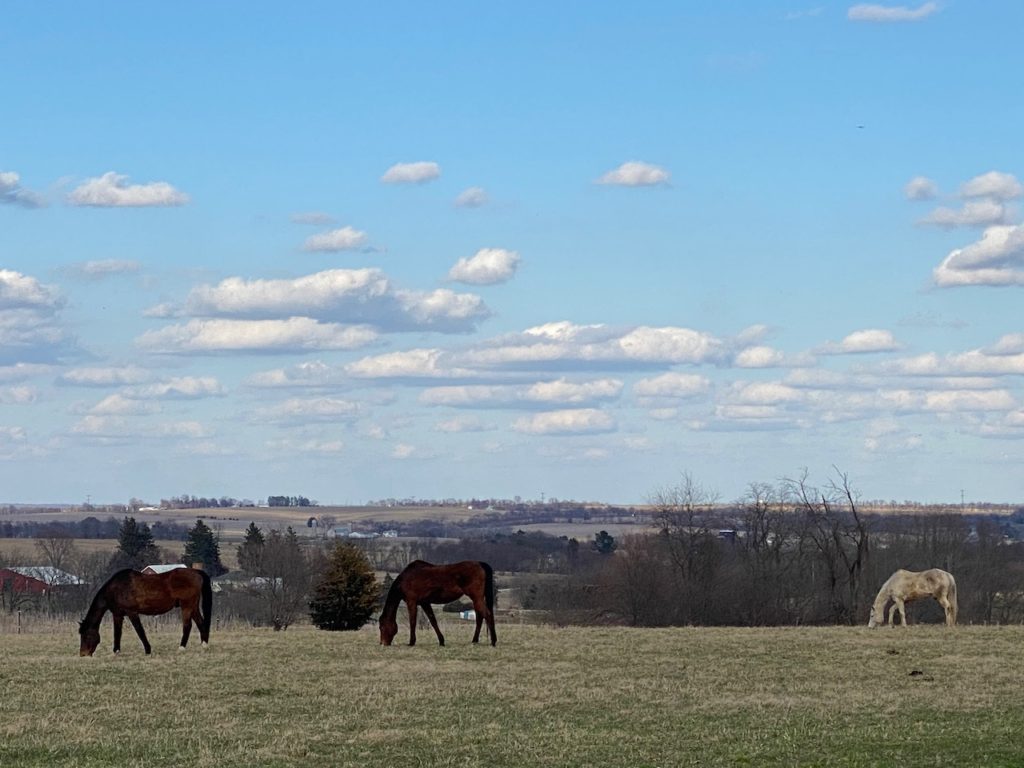
As we all honker down during this pandemic, please remember that we will find a solution. We just need to be kind and patient and not give into our fear. I cope by inhaling hope and exhaling fear. Give it a try or let me know what you are doing these days to cope.
A Note from Deborah:
If you like this story, please leave a comment. And if you are interested in seeing more about my horses, please sign up for my newsletter. That way you will get my next story in your mailbox as soon as it is available. I’ll be doing photos essays of my horses about once month. And thank you.
